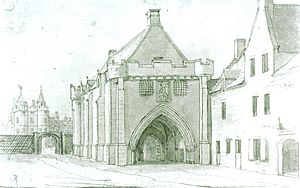James Douglas of Spott facts for kids
James Douglas of Spott (died 1615) was a Scottish landowner and a key figure in some important events during the reign of King James VI. He was the son of Regent Morton, a powerful leader in Scotland.
Contents
Early Life and Career
James Douglas was appointed Prior of Pluscarden in 1577 by his father. This gave him control over the abbey's lands. He also shared a lease for lead mines in certain areas of Scotland with Lord Glamis.
In January 1581, his father, Regent Morton, was arrested and taken to Dumbarton Castle. James Douglas was told he could not travel or come to Edinburgh, where his father's trial would be held. He later went to Carlisle in March 1581 and was protected by Henry, Lord Scrope.
The Spott Land Dispute
In 1577, James Douglas married Anna Hume. She was the daughter of George Hume of Spott. The lands and house of Spott are located in East Lothian.
In September 1591, George Hume, Anna's father, was killed. Horsemen shot him. People believed the horsemen were Humes from Ayton. They were reportedly angry about the king's favor towards Sir George Home, who was a relative of the murdered laird. Sir George Home believed that James Douglas had ordered the killing.
Why the Feud Started
David Hume of Godscroft, a historian, explained the background of this family dispute. He wrote that Alexander Hume of Manderston was married to George Hume's sister. Sir George Home, who later became the Earl of Dunbar, was the nephew of the murdered laird.
The old laird of Spott, George Hume, had been fond of Sir George Home. He might have planned for his daughter, Anna Hume, to marry Sir George. However, this plan changed because of an argument about land and crops. The old laird of Spott became unhappy and decided not to let his daughter marry Sir George Home. Instead, he went to Regent Morton and arranged for Anna to marry Morton's son, James Douglas. This decision disappointed the Manderston family, and they held a grudge.
Rebellion Against King James VI
Historians like Robert Johnston and John Spottiswoode wrote that Sir George Home pursued James Douglas of Spott for the murder of George Hume. Some of Douglas's servants were arrested and imprisoned at Holyrood Palace. This led James Douglas to join forces with the rebel Earl of Bothwell. Bothwell wanted to break into the palace and gain control over the king.

The Holyrood Palace Attack
According to Sir James Melville of Halhill, James Douglas was part of Bothwell's attack on Holyrood Palace on December 27, 1591. Douglas, along with others, went to free his servants. They were held in the gatehouse, also called the "porter lodge." They were suspected of murdering his father-in-law, the old laird of Spott. His servants had been subjected to a painful device called the "boot," which caused great pain to their legs.
This attempt to free the servants raised the alarm faster than Bothwell's group wanted. The king and his court quickly barricaded themselves inside the palace. Andrew Melville of Garvock brought help from outside.
The English ambassador Robert Bowes reported that two of Spott's servants were captured and one was subjected to the "boot" on Christmas Day. Another account said that Spott could not rescue a man whose legs were seriously injured. This account suggested that Spott joined Bothwell because of the harsh treatment of his servants.
The author of the Historie of King James the Sext wrote that Spott only came to free his accused servants. He named the injured man as "Affleck of Cumlachie." He added that Spott came to the palace before supper and spoke with the Chancellor, John Maitland of Thirlestane. Spottiswoode wrote that the Chancellor had spoken against the servants' treatment, but the king insisted on it.
After the Attack
More suspects for the murder of the old laird of Spott were found in England. They were taken to Berwick, which pleased Sir George Home. However, these prisoners escaped back into Scotland with the help of Archibald Douglas.
In March 1592, Spott fled to the English border, hoping for help from old friends. He had to write to Archibald Douglas for assistance. He claimed that members of the Manderston family had worked against him.
On June 7, James Douglas was accused of treason by the Parliament of Scotland. Many of Bothwell's followers were also accused. The king gave Spott's lands to Sir George Home on June 10.
On June 27, 1592, Spott joined Bothwell's attack on Falkland Palace. However, they could not reach James VI and Anne of Denmark, who stayed safe in the gatehouse tower. There was a rumor that Spott had been killed at Falkland.
In September 1592, Spott was reported to be at Drumlanrig Castle. He was discussing Bothwell's plans with Maitland. The English ambassador Robert Bowes heard in October that Bothwell might be better off without the Laird of Spott. He might gain the king's favor more easily if he "shook him off," as this would please other courtiers.
In August 1593, King James VI tried to help James Douglas. He sent his master of work, William Schaw, to Sir George Home. Schaw was to tell Home to return Spott's lands to James Douglas. Bowes heard that this move would be resisted.
In November 1594, King James VI wrote to Robert Bowes, who was in Berwick. The king complained that Spott and Thomas Cranstoun were living in England. He hoped Bowes could arrest them. Spott had gone to London and wrote a letter in Latin, which was unusual for him.
In February 1595, the English diplomat George Nicholson heard that Hercules Stewart, Bothwell's brother, blamed Spott for involving him with certain powerful earls. Hercules Stewart also claimed that Spott was guilty of his father-in-law's murder. King James VI removed Bothwell and Spott from the church. This was because they were at Menmuir, where the rebel earls made an agreement. Sir George Home told Nicholson in October 1595 that he was not making any agreements with Spott.
In May 1595, King James VI gave Sir George Home the lands of John Home, who was accused of the old laird of Spott's murder. In September 1595, Archibald Douglas wrote that Spott could travel to France. He was to meet the exiled Earl of Bothwell and convince him not to conspire with Spain. In March 1597, he tried to help in the Kinmont Willie border incident. In November 1599, he traveled to the English court from Carlisle. He carried a letter of introduction from Thomas Scrope, 10th Baron Scrope of Bolton.
Reconciliation and Later Life
James Douglas was reconciled with the king and Sir George Home in January 1603. Sir George Home was now the treasurer of Scotland. George Nicholson thought this was connected to efforts to help the Earl of Bothwell.
King James made James Douglas the chamberlain of Dunbar on April 13, 1603. In March, the Privy Council issued letters forgiving him. They also "relaxed him from the horn" for his part with Bothwell in the attacks on Holyrood, Falkland, and Leith. This meant he was no longer considered an outlaw.
In June 1603, Douglas complained to the Privy Council about a piece of unused land near Dunbar Castle. The king had recently given it to him after his "long banishment." A lawyer had caused some problems with fees for the official documents. The lands of Spott were made into a free barony in August 1605.
In July 1610, a "James Douglas of Spott" was described as a gentleman of the king's private staff. He was also made a citizen of England. He was granted lands in County Armagh. However, some historians believe this was a different James Douglas of Spott. This other James Douglas was the son of Malcolm Douglas of Mains and served Prince Henry.
James Douglas of Spott, who had once conspired with the Earl of Bothwell, died in 1615.
Family Life
James Douglas married Anna Hume, the daughter of George Hume of Spott. They had several children:
- Archibald Douglas of Spott, who became his heir.
- Christian Douglas (died 1615), who married John Auchmoutie of Scoughall.
- Archibald Douglas of Grene.
- Margaret Douglas, who married John Tweedy younger of Dreva.
- Elizabeth Douglas.


